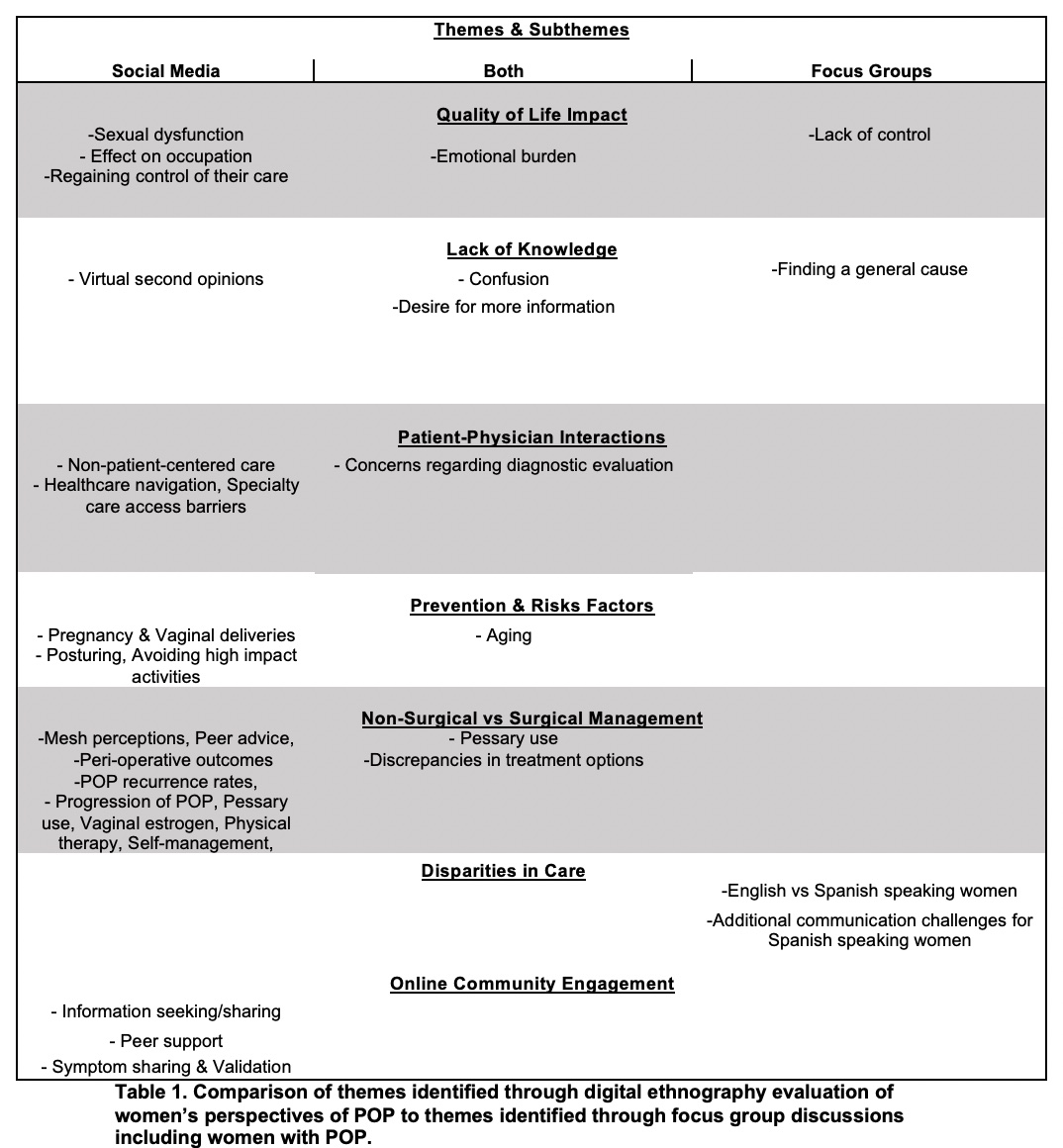Back
Poster, Podium & Video Sessions
Podium
PD44: Urodynamics/Lower Urinary Tract Dysfunction/Female Pelvic Medicine: Pelvic Prolapse
PD44-11: Understanding Patient Pelvic Organ Experience Comparing Digital Ethnography and Focus Groups—Which One Does Better?
Sunday, May 15, 2022
11:10 AM – 11:20 AM
Location: Room 243
Gabriela Gonzalez*, sacramento, CA, Kristina Vaculik, Beverly HIlls, CA, Corey Arnold, los angeles, CA, Christopher Almario, Brennan Spiegel, Beverly HIlls, CA, Jennifer Anger, La Jolla, CA
- GG
Gabriela Gonzalez, MD, MPH
Resident Physician
Podium Presenter(s)
Introduction: Prior qualitative focus group studies conducted at academic medical centers have elucidated our understanding of patients’ experience managing pelvic organ prolapse (POP). However, now that social media is highly sought after to answer medical concerns, we can utilize data from online forums to passively learn from patients. This study aimed to compare patient perceptions of POP discovered through internet research versus focus groups. Comparing results from both methods will enhance our understanding of women’s experience with POP and support the analysis of online forums for qualitative studies with interventions.
Methods: We compared our prior digital ethnography analysis themes based on 3,451 posts identified from 117 websites using a data mining service (Treato) to data from four published POP focus groups. Three focus groups were conducted at UCLA, Cedars-Sinai, Olive View, and University of Mexico medical centers. The fourth study was conducted at the University of Pittsburgh. Women were recruited from specialty centers to participate in the focus groups. The themes from online forums were compared to those from all the focus groups.
Results: Each theme from the focus group data also emerged in our social media analysis. Interestingly, one of the focus groups highlighted differences among English and Spanish-speaking women diagnosed with POP, which we could not analyze with social media. Thematic findings from forums were more detailed and identified novel themes not previously elicited with patient interviews (Table 1). Unique online themes focused on surgical perceptions, decision making, online peer engagement, and non-evidence-based perceived risk factors. The social media themes were more detailed with candid, private insights based on online forum text, likely due to the freedom provided by the internet.
Conclusions: Our study confirms our understanding of women’s experience with POP, and it supports the reliability of conducting qualitative analysis using social media. The inherent anonymity of digital ethnography allows for candid personal, and unbiased information to be collected. Although online forum analysis provides access to extensive, diverse data, it may not be the best method of studying disparities in care.
Source of Funding: NIDDK PLUS Research Consortium

Methods: We compared our prior digital ethnography analysis themes based on 3,451 posts identified from 117 websites using a data mining service (Treato) to data from four published POP focus groups. Three focus groups were conducted at UCLA, Cedars-Sinai, Olive View, and University of Mexico medical centers. The fourth study was conducted at the University of Pittsburgh. Women were recruited from specialty centers to participate in the focus groups. The themes from online forums were compared to those from all the focus groups.
Results: Each theme from the focus group data also emerged in our social media analysis. Interestingly, one of the focus groups highlighted differences among English and Spanish-speaking women diagnosed with POP, which we could not analyze with social media. Thematic findings from forums were more detailed and identified novel themes not previously elicited with patient interviews (Table 1). Unique online themes focused on surgical perceptions, decision making, online peer engagement, and non-evidence-based perceived risk factors. The social media themes were more detailed with candid, private insights based on online forum text, likely due to the freedom provided by the internet.
Conclusions: Our study confirms our understanding of women’s experience with POP, and it supports the reliability of conducting qualitative analysis using social media. The inherent anonymity of digital ethnography allows for candid personal, and unbiased information to be collected. Although online forum analysis provides access to extensive, diverse data, it may not be the best method of studying disparities in care.
Source of Funding: NIDDK PLUS Research Consortium


.jpg)
.jpg)